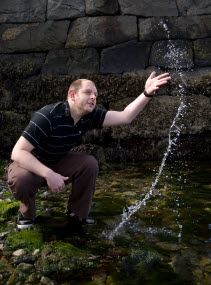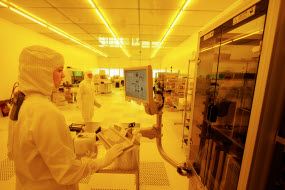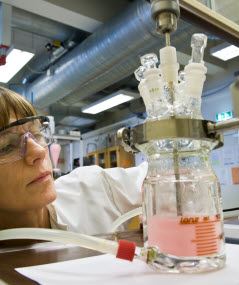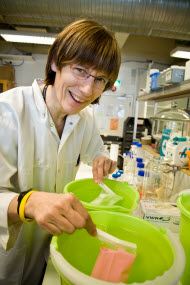by Christina B. Winge and Åse Dragland

|
|
Andy Booth is leading a project called “The environmental fate and effects of SINTEF-produced nanoparticles". |
I glance at my own fridge, and see that the family kitchen has more to offer than I had known. The TV journalist had done his job; I now realise that, all unaware, I am already a nano-consumer.
The following day I ring the importer to ask about the silver in my fridge. The coating has clear health benefits, I am told. I also call the Norwegian Technology Council, which thinks that nanosilver is unlikely to have any effects at all. On the forskning.no (research.no) web-site, however, I read that a number of international scientists are now warning against the uncritical use of this type of solver. The silver has turned out to be lethal to important organisms such as earthworms, if it gets into the soil.
The severest critics go so far as to claim that nanoparticles in the wrong place can lead to cell death, changes in our genetic material and the development of serious illnesses.
I have to recognise that I would not have bought my silver-coated fridge if the salesperson had explained that I was adding the nano-age to my potato stew.
There seem to be good reasons for finding out a bit more about this invisible technology that has discreetly crept into our everyday life. Is it dangerous, useful or both at the same time? And what do we really know about the consequences of using it?
Not all particles are hazardous
On the fourth floor of a modern building on the Brattøra Quay in Trondheim, an Englishman is feeding exotic little aquarium fish in his office.
“Look, this is my favourite,” he says, pointing to a golden fish with black spots that lies on the bottom of the tank. He introduces himself as Andy Booth, SINTEF scientist and environmental chemist who is interested in what nanotechnology is doing to the marine environment.
A couple of years ago, he began to be interested in whether nanoparticles could be hazardous.
“So I started to agitate for my department to apply for internal project funding to study this topic. And we were given the funds.”
Now, Booth is leading a project called “The environmental fate and effects of SINTEF-produced nanoparticles”, which is being paid for out of SINTEF’s own research funds.
To explain the concepts involved: “Fate and effect” means that the scientists will study both how the particles behave and how they affect organisms when they are released into the marine environment, which in this context is defined as soil, rivers, lakes and the sea.
One of the goals of the project is to find out whether nanoparticles are toxic to marine organisms such as small crustaceans and animal plankton. Further down the road, the ability of cod larvae and other large organisms to tolerate nanoparticles will also be studied.
“Our experiments will tell us whether these tiny particles will be excreted or remain inside organisms, and if they do, how they will behave there,” explains Booth, who wants to make it clear that not all nanoparticles are necessarily dangerous. Many types of nanoparticles occur naturally in the environment, and have existed ever since the Earth was formed. For example, ash is a material that contains nanoparticles.
“What is new is that we are now capable of designing nanoparticles with a wide range of different properties. Such particles can be different from those that already occur in nature, and they are intended to perform specific tasks at our command, so we do not know how they will behave in nature. “This could potentially – and I say “potentially” because this topic is so new to science – indicate that these particles could be toxic under certain conditions. However, this depends on a number of factors, including their concentration and the combination of particles,” emphasises Booth.
“Has industry good enough tests to ensure that the nanoproducts that it release in the market are good enough?”
“That is a good question. In the field of chemical analysis, we have standard tests that tell us whether or not a material is toxic. Today, there are no such tests of nanoparticles that are 100% accurate, so this is something that scientists are currently working on at international level,” says Booth, adding that he believes that it is extremely difficult to put products that are a danger to health on the market.
Survey of millions is essential
The nanoparticle concept is general, and includes many more than one type. There are millions of potential variants, Today, it is impossible to obtain an overview of how many there actually are, and some of them will be toxic, while others are harmless, just like other chemicals.
This is why Andy Booth and his 12-strong team at SINTEF have just launched their painstaking efforts. One of the biggest challenges they have faced so far is that of identifying scientific methods that will enable them to discover how these tiny particles behave in nature, and how they might affect natural processes.

|
|
Industry is now starting to adopt the new technology on a large scale. Photo: Thor Nielsen. |
Industrial breakthrough
About 500 kilometres away in the heart of Oslo, Booth’s colleague Christian Simon sits with his nose in a pile of papers, ignoring the birdsong and summer flowers just outside his window. This summer, other matters have been more important. His research department at SINTEF Materials and Chemistry has recently made the most important industrial breakthrough ever in nanoparticle technology, and in this case it looks as though nanosubstances could be environmentally friendly alternatives to chemicals.
Norway’s leading manufacturer of powders and paints, is about to start production of a new type of paint containing nanoparticles, and it has been developed by SINTEF.
The particles possess fluid characteristics that make the paint easy to apply. This means that a higher proportion of dry matter can be used, with correspondingly less solvent. Furthermore, the paint will dry rapidly and be more wear-resistant than normal paint.
“We have already signed licensing agreements with Jotun for certain applications, and are currently in the upscaling phase, during which Jotun will produce three tonnes of nanoparticles. The product will be delivered in the autumn, but there are still a few things to be tested,” says Simon.
“But what happens when materials painted with nanoparticles are demolished, chopped up or burnt? Will hazardous components escape to the environment?
“The particles have been produced in such a way that they create chemical bonds to the other components of the paint. When the paint is fully cured, therefore, the nanoparticles no longer exist, so they cannot separate from the polymer matrix when whatever has been painted is torn down, chopped up or burnt,” answers Christian Simon.
More industry
According to Dag Høvik, who has led the Research Council of Norway’s major Nanomat programme since 2002, industry is now starting to adopt the new technology on a large scale. Last year alone, four new companies were established as a direct consequence of the programme. Four patents have also been granted.
“Since the start of the programme, more than MNOK 670 has been allocated to research on nanotechnology and new materials. The aim of this effort has been to give Norway a solid basis for innovation and industrial growth in this field. Industry itself has also put more than MNOK 150 into the R & D pot,” says Høvik.
Around a quarter of the money has been put into research on new functional materials – what are known as nanostructured materials that have completely now properties. About 30 percent has gone into in energy and environmental technology projects, from hydrogen research to the development of fuel cells and improvements in solar cell technology. And 18 percent of the funds from the Nanomat programme has gone to ICT projects.
Environmental bombshell?
Toril Hofshagen thinks that research on industrial potential is all very well, but that it is just as important to study how nanoparticles affect the environment. Hofshagen is an engineering graduate and Assistant Director in Norsk Vann, a not-for-profit industry organisation for Norway’s water and waste sector.
She is far from happy that nanoproducts are now to be found on supermarket shelves.
“Norsk Vann has long been aware of the march of nanoparticles. Our anxieties focus on what happens to these bactericidal particles when they finally end up in sewage,” she says.
The reason for Hofshagen’s anxieties is that wastewater is an important renewable resource, which is purified before being returned to its sources in Norwegian nature. The other result of the purification process is activated sludge, which is treated and quality assured before it is used. Today, nearly 90 percent of treated sludge is used as a fertiliser and soil improver in agriculture and green areas. This means that the nanoparticles that are carried into wastewater by products and via other uses in homes and industry are potentially a problem for the wastewater industry. In the worst case, the nanoparticles can damage the biological processing that takes place in the wastewater purification system and contaminate the water into which the purified water is released. The sludge itself may also be of poorer quality as a soil improver.
“The Norwegian water and wastewater sector is quite simply afraid that nanoproducts could be the environmental bombshell of the future, just as DDT and PCBs turned out to be in their time. We have already started using a number of nanoproducts without knowing enough about their impact on the environment,” says Hofshagen.
“Nor do we know for certain what the consequences of such products will be for our health,” she says, mentioning the report of the Norwegian Institute of Public Health called “Environment and Health – a research-based knowledge base” (2009:2).
According to the report, there is a theoretical possibility that nanoparticles could break through biological barriers (skin, mucous membranes, cell membranes) and thus enter our bodies by accident.
“Nanosilver is an example of a type of nanotechnology that in our opinion is used far too much in various products. It is known that nanosilver kills 650 different bacteria and viruses. So it is not necessarily a good thing that it should come into contact with our bodies or enter the water supply.”
“But few people seem to be publicly criticising nanotechnology?”
“Yes; these developments are being driven by desire for new functional products, while manufacturers don’t take enough time to identify any hazardous effects of products before they are put on the market.”
Toril Hofshagen believes that in the final analysis it is the authorities that have the responsibility and the means to regulate this field.
“The problem is that today there are no regulations that are tailor-made to control potential negative effects of nanotechnology. But as far as we know, this is something that both the health and environmental authorities are currently working on.”

|
Lab on a chip
“The emerging environmental problems related to nanotechnology are probably due to the size and shape of the particles, rather than to the nature of the materials themselves,” says Liv Furuberg, who works at MiNaLab, the laboratory for microsystems and nanotechnology. The laboratory is squeezed into a building in Gaustadbekkdalen in Oslo, and it is owned by SINTEF and the University of Oslo.
Up on the fourth floor we enter a white, airy room. Scientists in clean-room clothing pass, only their eyes visible behind protective spectacles. The air is purified by filters mounted in the ceiling. White mats to capture dust are laid at every door.
Clad in a white coverall and wearing gloves and a face mask, Liv Furuberg sits at a microscope holding a rather unusual plastic chip in her hand. In fact, the chip contains a complete microlaboratory.
Several of SINTEF’s research groups are collaborating on the task of shrinking the large analytical laboratories that we are familiar with from hospitals down to miniature versions the size of a credit card.
The tiny diagnostic system can automatically perform advanced analyses of blood, urine and other bodily fluids. The card/chip is engraved with icroscopic channels and capillary structures. In the walls of the of these channels, the scientists use nanotechnology; molecule-thick layers that ensure that the chip operates as a biological system, so that they can read off the results of their tests.
“We build up individual layers of molecules in order to obtain surfaces with sensitive areas. These can react with and thus measure individual molecules that act as markers of specific diseases, for instance in blood,” says Furuberg.
“Could these chips lead to new types of environmental problems?”
“No. This technology utilises functional thin films as the surface of large chips. We are working at the nanometre level, but there are no nanoparticles involved, only nanostructured surfaces, and the chemical compounds these employ are exactly the same as those used in normal laboratories,” answers Furuberg. “Analyses performed in microchips actually produce much less waste than conventional diagnostic systems. In our case, no particles are involved, only thin films.”
Hybrid materials
While the lab-on-a-chip technology is still in the starting box, nanoparticles and nanocapsules have gradually become a gilt-edged field of research for Christian Simon and his SINTEF colleagues. One technology after another has been patented. The opportunity to create a new industry beckons from afar.
“What is new is that we combine inorganic, tough, hard materials with organic, flexible, and formable materials when we create our nanoparticles. This gives us a new class of materials with improved properties; what are known as hybrid solutions. For example, we can make polymers with improved light stability that will also withstand scratches,” says Simon.
When a hollow nanoparticle is created, it is called a nanocapsule. The cavity can be filled with another material for subsequent release for any of a wide range of purposes. The SINTEF scientists have not come as far with nanocapsules as they have with nanoparticles, but they have developed a technology that can be used in several applications and they can produce nanocapsules on a large scale.
“For example, we can improve the durability of coatings for aircraft, ships and cars,” says Simon.
“With paint?”
“Yes, with paint or enamel that contains nanocapsules with special paint and enamel components.”
“What is this advance based on?”
“The components consist of substances that can close up cracks and scratches. Just think of vehicle bodywork. When gravel hits its surface, the enamel cracks and gets damaged. But simultaneously, the capsules inside the enamel burst and the material they contain will repair the damage.
“Surgical” medical treatment

|
|
Ruth B. Schmidt is concentrating in medicines to fight cancer, and use nanocapsules inside the body. Photo: Thor Nielsen. |
“When you take an ordinary tablet it ends up in the stomach, no matter which part of your body is sick. In the same way, medicine injected into a blood vessel will diffuse throughout your body via the bloodstream. But if we fill nanocapsules with medication, we can steer them to wherever we want their contents to end up.
Scientists do this by binding special molecules to the coating. The capsule’s shell is broken when its immediate environment is right in terms of the selected trigger, such as temperature or acidity. According to how the capsule has been concocted, its contents can be allowed to leak out gradually over time, or at a higher rate at first and gradually less as time goes by.
At the moment, Ruth Schmidt and a group of SINTEF chemists are concentrating on medicines to fight cancer, a long-term project that offers important challenges. The use of nanocapsules inside the body makes serious demands of the materials used. The particles that are being developed for medical purposes must be non-toxic and need to be broken down into non-hazardous components that the body can excrete, for example via the urine. The capsules also need to head for the right site of action and to liberate their contents, without being discovered by “watchdogs” such as T cells and natural killer cells.
“Nanoparticles that are put into the body – aren’t they a health hazard?”
“No; in this case these capsules are a plus.”
“Really?”
“Yes, because here we want the capsules to pass through the cell membrane and do their work locally. Other types of nanoparticles can pass the membrane and become a danger to the body. The risk of nanotechnology is that sometimes they are not supposed to pass, or that they accumulate in large quantities over a period of time, instead of disappearing.”
“What might happen in such cases?”
“We still don’t know much about that. We don’t use nanotubes or nanofibres, because we believe that they are less safe than particles. But a lot of research is being done in this field.”
Hunting for side-effects
Among those who are concerned about the potential effects of nanotechnology on the human body are Tore Syvertsen and his team at the Department of Neuromedicine in NTNU. They have tested how rat brain cells react to a range of carbon-based nanomaterials such as nanofibres and –tubes.
Nanomaterials of this sort have many applications, and little is known about their potential effects on health. For this reason, the scientists have been studying a number of carbon-based nanomaterials by placing the fibres in cell cultures extracted from the brains of rats. This has revealed how the cells react with each type of nanoparticle. And they were not unaffected: most of the cells turned out to be fairly sensitive to these substances, whose thickness and length was very important even when their chemical make-up was identical.
“This shows that there are good reasons for studying where the boundary between hazardous and non-hazardous nanotubes lies,” says Syvertsen. “Other studies of similar carbon fibres have shown that they can cause a type of lung cancer that is otherwise best known for being due to exposure to asbestos. Since this type of cancer takes a long time to develop it is essential to test such materials before they come into widespread use.”
This project was financed through an agreement between the Research Council of Norway and industry. It has now come to an end, and no money was available to continue it.
“A great of money is being put into developing nanotechnologies, but very little into research on their potential consequences. We never learn, not even at NTNU,” says the professor.

|
Ethics – doubt and credibility
So there is great potential, but also a high degree of uncertainty, is the conclusion when Gemini brings the topic of nanotechnology up with its various sources. How should we treat this uncertainty? As consumers, can we and should we trust the technologists and market forces?
Can it be that nanotechnology was oversold when the subject emerged during the nineties? Were we simply blinded by its potential, with the result that we forgot to look out for its potential disadvantages?
Bjørn K. Myskja works in a tall glass-fronted building on NTNU’s Dragvoll campus. He is that rara avis, an ethicist with a doctorate in philosophy, and he responds to the question with a “Well, perhaps”. Myskja thinks that the problem with nanotechnology is that we still lack a basis for calculating the risks involved, because we do not have sufficient experience of the field.
“Sometimes, science and the experts have oversold the positive aspects of a technology. This can lead in turn to an excessive focus on its negative aspects”.
One example of biotechnology that was given a sceptical reception was the experiments of the Hungarian protein scientist Árpád Pusztai. He fed rats genetically modified potatoes, which led to changes in their digestive system and created a scientific controversy: critics claimed that this was because the research design was poor, while others felt that the lesson to be drawn was that gene technology was not yet safe enough for food production. This uncertainty led to a serious and widespread lack of confidence in biotechnology.
Myskja’s everyday work is on bioethics, and at the moment it is the interface between biotechnology and nanotechnology that is occupying the ethicist.
“In the project I am working on just now, we will be studying a research group that is developing a fish vaccine. This will be taken up by fish with the aid of nanoparticles, which is a non-traditional method of administering a vaccine. My role is simply to look at how the use of nanotechnology in biology affects public confidence, or that of society, if you prefer. This is an important reason why ethicists are now joining various nanotechnology research projects.
“If science is to work for the common good, more people than just technologists must be involved in decision-making about the adoption of new technology. Laymen have a different understanding of the reality in which technology is used. Their understanding ought to be an important part of the basis for deciding whether to adopt new technologies,” says Myskja.
Good technology advice is expensive
Gemini rings the Norwegian Technology Council in order to find out what it thinks about nanomaterials and their environmental impact. The Council is an independent body that identifies important technological challenges and encourages debate about their potential and consequences for ourselves as individuals and for society in general. The Council is also expected to provide Parliament and the authorities with advice about technological choices.
We get project manager Jon Magnar Haugen on the line.
“How can consumers know whether a product is safe?”
“Expecting consumers to evaluate such things is really to begin at the wrong end, which is why the authorities need to tidy up. What we need is better classification and differentiation – we need to distinguish between what is safe and what is dangerous.”
“No-one really knows how many different nanomaterials exist. Doesn’t this make your job seem impossible?
“The first challenge is to know what can be classified as nanoproducts. Lots of products are manufactured with the aid of nanotechnology, without the end product containing nanoparticles. At the moment, we find that the number of nanomaterials used in products is relatively modest. If we have to clean up this jungle of substances, we have dealt with major tasks before, for example we have managed to sort and deal with our chemicals in a sensible way. If it turns out that nanoparticles accumulate and in food chains, then it will be necessary to sound the alarm, but of course it is difficult to stop developments.”
“Have you an overview of how many nanoproducts are in use in Norway?”
“So far, we don’t have a good overview, but the authorities have recently started work on this topic,” says Haugen.
“Can nanoproducts be recycled?”
“That’s an interesting topic. What we are afraid of is that when nanoparticles are added to certain types of plastic in order to give them particular properties, the plastic will no longer be suitable for recycling. So that is a problem that needs some study.”
The EU Is currently writing a set of regulations for antibacterial substances, and is looking at which ones should be permitted. These studies will be of great importance for us here in Norway too.”
The way ahead
Dag Høvik in the Research Council of Norway supports the Technology Council’s argument that more research is needed on the unknown environmental impact of nanotechnology.
“Of a total of 130 Nanomat projects, six deal with ethical, societal or HSE/risk aspects; this number includes the ELSA programme. Norwegian scientists are also taking part in four EU projects on such topics. We ourselves have been cooperating with the Technology Council and the National Research Ethics Committee for Science and Technology since 2004.”
“Is that sufficient?”
“No, but it is important to make it clear that much of the funding that we have allocated in the past few years is earmarked by government departments. I myself would like to have seen more of the money going to HSE projects in nanotechnology, since research on nanotechnologies and new materials will continue to be important after 2011,” says Høvik. “So this autumn we will be asking for input from the academic community, industry and other stakeholders.”
Needle in a haystack
While the authorities are mapping the use of nanomaterials and the Research Council plans new measures, Andy Booth and his colleagues carry on tirelessly with their experiments.
“When nanoparticles are released into rivers and lakes, it is a rather complicated matter to study how they will behave. Chemistry is different at nanometre level, and nanoparticles do not behave like normal particles,” says Booth.
As an example, he mentions silver, which is a metal much used in jewellery that comes into intimate contact with the skin, without being in any way hazardous. But silver nanoparticles have quite different properties, as we know. They are bactericidal, just like antibiotics.
“These particles also behave differently in fresh- and salt-water. Finding methods that will enable us to study their behaviour is essential,” says the environmental chemist.
“What methods do we have?”
“We can add a fluorescent marker to the particles. When we test the sample in a spectroscopic camera, the marker will light up and distinguish such particles from other particles.”
Nanoparticles can also aggregate and become so heavy that they sink into the sediment, which makes them less likely to affect organisms that live in the water column itself, and instead impact those that live in the river-bed.
“The big question now is to find out how high concentrations we need to test in order to be on the safe side. It is not worth taking chances with nature,” concludes Andy Booth.
He describes himself as a technology optimist. Not only does he have nanosilver in his fridge without losing any sleep over it, he even thinks it is quite cool!
